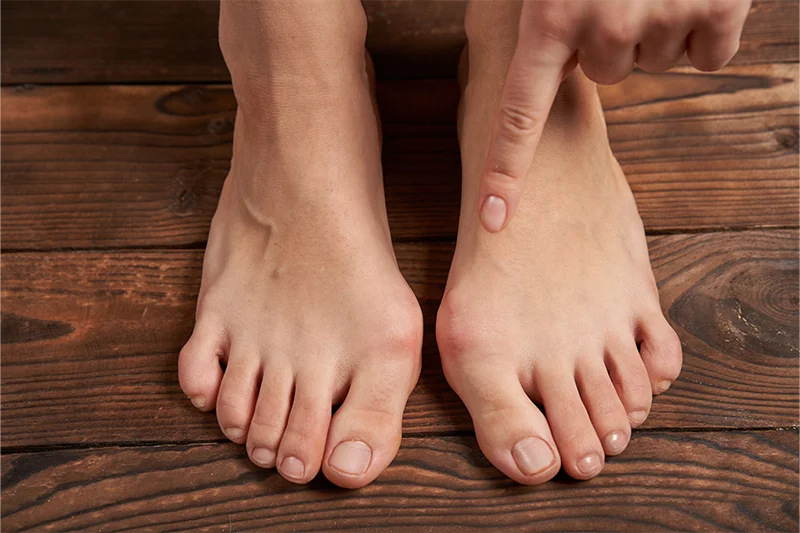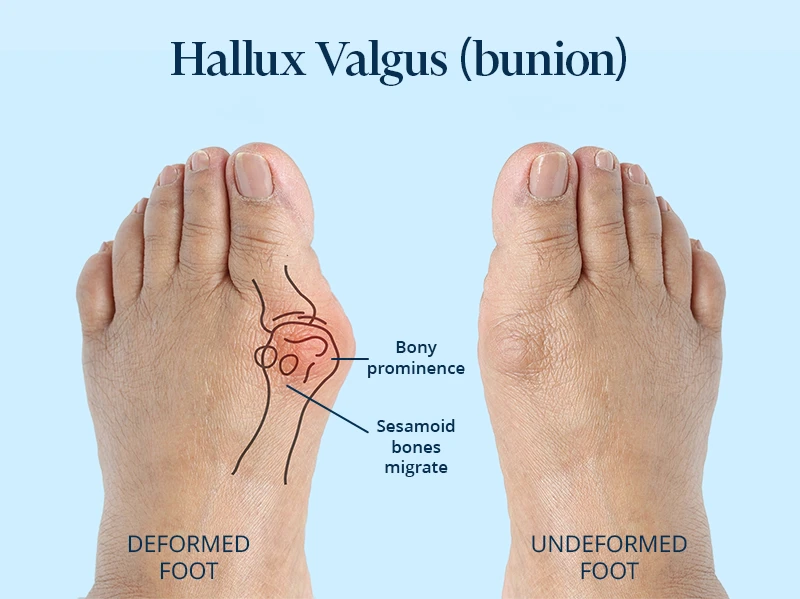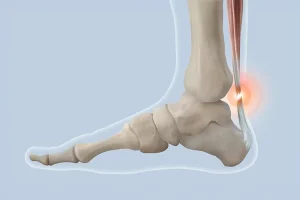Hallux Valgus (bunions)
The only effective solution for correcting them is surgery hallux valgus surgery
Home » Orthopedic Surgery » Hallux Valgus (bunions)
Conditions Treated

Hallux valgus, also known as bunions, is a foot deformity that causes pain and discomfort. Surgery is often necessary to correct this condition and improve quality of life.
Book an Appointment
What is hallux valgus?
Hallux valgus, also known as bunions, is a foot deformity that affects the joint of the big toe. In this condition, the first metatarsal (the bone at the base of the big toe) gradually shifts toward the inside of the foot. In addition to the deformity of the big toe, toes 2-5 may also be affected, leading to joint stiffness and intense pain.
Causes and risk factors
Bunions mainly affect women (approximately 90% of cases), which has led to the assumption that tight shoes are a major cause. However, statistical studies show that bunions do not occur because of shoes, but have a multifactorial origin. The deformity often begins in adolescence, before those affected start wearing “fashionable” shoes.
Data shows that 50% of women with hallux valgus have never worn tight shoes or high heels. Furthermore, the incidence of bunions is similar in communities that wear shoes and those that do not. However, wearing inappropriate shoes can aggravate an existing deformity because it puts pressure on the forefoot and destabilizes the big toe joint.
- Genetic predisposition: If one of the parents had bunions, the risk of developing this condition is higher.
- Structural abnormalities of the foot: Short metatarsal bones or weak ligaments can contribute to the development of bunions.
- Associated conditions: Rheumatoid arthritis and other inflammatory conditions can promote the development of this problem.
- Inappropriate footwear: Narrow shoes or high heels can aggravate foot deformities.
The bunions dissolve in 2 days?
The bunions (hallux valgus) do not disappear in two days. They are a bone deformity of the big toe joint and do not disappear without specialized treatment, especially not in such a short period of time.
- Bunions are a chronic orthopedic problem and cannot be eliminated with creams, patches, or natural remedies.
- The only effective method of correction, in moderate or severe cases, is surgery.
- If you have already undergone surgery, it is important to know that absorbable sutures or local post-operative swelling do NOT disappear in 2 days. The sutures may begin to dissolve after 7-10 days and the inflammation gradually subsides within a few weeks.
Bunions treatment
Mild hallux valgus
- Description: The deviation of the big toe is minimal, with an angle of deviation of less than 20 degrees. Symptoms are often absent or minor.
- Treatment: Wearing appropriate footwear and using orthotics is recommended to prevent the progression of the deformity.
Moderated hallux valgus
- Description: The deviation of the big toe is more pronounced, with an angle of deviation between 20 and 40 degrees. Pain and difficulty wearing certain types of footwear may occur.
- Treatment: In addition to conservative measures, minimally invasive procedures may be necessary to correct the deformity.
Sever Hallux Valgus Surgery
- Description: The deviation of the big toe exceeds 40 degrees, which can lead to significant pain and major difficulties in walking.
- Treatment: Surgery is often necessary to correct the alignment of the bones and restore the functionality of the foot.
Why choose surgical treatment?
- Proven effectiveness: Surgery corrects the deformity and eliminates the associated pain.
- Quick recovery: Modern techniques allow for a shorter and less painful recovery.
- Personalization: The treatment plan is tailored to the individual needs of the patient.
Steps to benefit from hallux valgus surgery
- Medical consultation: Schedule a consultation at the VenArt Clinic to assess your condition.
- Diagnosis and treatment plan: The specialist will determine the diagnosis and propose the most appropriate treatment plan.
- Surgery: If recommended, the procedure will be performed by a specialized medical team.
- Recovery: Follow the postoperative instructions for an effective recovery.
Hallux valgus surgery price
The cost of hallux valgus surgery may vary depending on the complexity of the case and the medical institution chosen. For accurate pricing information, we recommend contacting one of our specialists directly.
Postoperative recovery after hallux valgus surgery
After surgery, the patient can walk on the operated leg in 1-4 weeks, depending on the complexity of the procedure. It is recommended to use crutches or a walking frame and wear special shoes for 6-8 weeks. Returning to normal footwear is possible after about 8 weeks.
- Suture removal: Approximately 14 days after surgery;
- Wearing special footwear: 4-8 weeks (support on the heel, no contact of the forefoot with the ground);
- X-ray check: 6 weeks after surgery;
- Return to work: 2-4 weeks;
- Intense physical activity: 8-12 weeks;
- Resuming driving: Approximately 6 weeks after surgery.
Risks after surgery
- Infections: Requires antibiotic prophylaxis;
- Deep vein thrombosis: Prevented by anticoagulant treatment;
- Pain and inflammation: Controlled with analgesics and anti-inflammatories;
- Numbness of the operated area: May last 24-36 hours, but must be monitored;
- Headaches: Possible for 12-24 hours due to spinal anesthesia;
- Delayed healing: May occur in cases of associated conditions or complications.
Why choose VenArt Clinic?
- You have access to a team of specialists with extensive experience in orthopedic surgery.
- You benefit from a quick recovery thanks to the modern techniques we use.
- You receive personalized care from a dedicated team, ready to offer you the best solutions for your health.
If you need more information or would like to schedule a consultation, please do not hesitate to contact us.
Medical Team
Frequently Asked Questions
How long does recovery take after hallux valgus surgery?
Recovery varies between 2 and 6 weeks, depending on the type of procedure and compliance with the doctor’s instructions.
Can the mounts reappear after surgery?
Modern techniques significantly reduce the risk of recurrence, but wearing appropriate footwear and maintaining an optimal body weight are essential for preventing the recurrence of the deformity.
Are there any treatments that can dissolve blackheads in 2 days?
There is no scientific evidence to support this claim. Hallux valgus is a bone deformity that cannot be eliminated instantly, but requires either conservative treatment or surgery.
When is surgery recommended?
Surgery is recommended when pain is persistent, affects daily activities, and deformation progresses despite conservative measures.
Schedule now for hallux valgus
Please fill out the form below, and our team of specialists will answer any questions you may have and provide you with a plan tailored to your needs.









